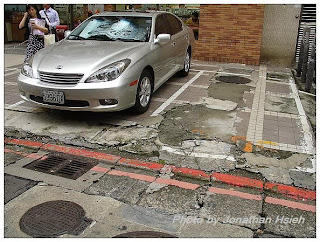jonathan0777, 混凝土補丁的台北市人行道, 意像圖建築空間研究所, 2009-10-05作者 Jonathan Hsieh 很用心地、圖文並茂地比較了國內外人行道施工及使用情形,教人感慨。話說回來,何止只是各類工程,在我看來,在台灣的每一個領域皆然,包括音樂、藝術工作。另一方面,台灣並非沒有人才,也非台灣人就缺乏嚴謹的工作態度及龜毛的需求,該文作者謝先生就是一例。而是這些人嚴謹的標準與工作精神在台灣的「主流文化」下,常常遭受反淘汰的命運。既然是「主流」,那麼,會不會也是「多數」呢?我其實並沒有答案。
http://jonathan0777.pixnet.net/blog/post/29474741
後記 2012-10-25
咦?上次怎麼會忘記提起台灣的核安問題?其實,有什麼人行道施工心態及品質,也會有什麼核電廠。走在台灣的街道上,最吸引我注意的往往是螺絲鎖得歪歪斜斜的各類電桿,而根據最近核電廠的新聞事件,尤其是核四,我們無法貿然假設,那邊的螺絲會比我在街上看到的來得中規中矩。
正如我在另一篇〈台灣核安要聞 2012, 2011〉[a] 所提起的「運氣」,換句話說,我們的核安現況像極了一台還沒有當過機的電腦。當然,這台電腦也可能永遠都不會當機,但是這實在需要再多一點點運氣。今天又在這一篇加入一則七分鐘微電影,裡面有以下這段文字:
核一、核二緊鄰「山腳斷層」
隨時可能引發規模 7 以上地震
但核一廠耐震係數僅福島核電廠的一半
核一廠存有 5614 支使用過的燃料棒
核二廠有 7896 支 核三廠有 2465 支
相當於 23 萬顆原子彈的輻射物質
對於使用過燃料棒的處置方式
台電至今尚未提出
2011 年 4 月,〈Nature〉雜誌將台灣核一廠選為
全球最危險核電廠第 3 名 核二廠則是第 2 名
同年,〈華爾街日報〉評點出全球 14 座最危險核電廠
我國 4 座核電廠全部上榜 [3]
國際核能專家小出裕章指出
台灣若發生輻射外洩,一個月內將有 3 萬人猝死
其後將有 700 萬人罹癌死亡
殺死我們的,不是明天的輻射
而是今天的冷漠
Related Articles
[a] 2012-06-19 台灣核安要聞 2012, 2011
http://kolmogolovi.blogspot.tw/2012/06/bwr-core-shroud-2012.html
External Links
[1] Declan Butler, Reactors, residents and risk, Nature News, 2011-04-21
http://www.nature.com/news/2011/110427/full/472400a.html
A world population analysis reveals the locations that could put
the most people in danger should a nuclear accident occur.
Population density is one critical lens through which other risks have to be assessed, says Laurent Stricker, a nuclear engineer who is chairman of the World Association of Nuclear Operators (WANO), created as an international forum on nuclear safety in the aftermath of the 1986 Chernobyl accident. "We need to look at the safety of reactors taking into account where they are," he says (see Nature 472, 274; 2011).[2] Nuclear power in Taiwan, Wikipedia
To carry out the population analysis, Nature teamed up with the NASA Socioeconomic Data and Applications Center based at Columbia University (see 'How population sizes were estimated' for an explanation of how the analysis was carried out). The KANUPP plant in Karachi, Pakistan, has the most people — 8.2 million — living within 30 kilometres, although it has just one relatively small reactor with an output of 125 megawatts (see 'Nuclear neighbours'). Next in the league, however, are much larger plants — Taiwan's 1,933-megawatt Kuosheng plant with 5.5 million people within a 30-kilometre radius and the 1,208-megawatt Chin Shan plant with 4.7 million; both zones include the capital city of Taipei. The findings of Nature 's population analysis are "scary", says Ed Lyman, a nuclear expert with the Union of Concerned Scientists in Washington DC.
http://en.wikipedia.org/wiki/Nuclear_power_in_Taiwan
Active seismic faults run across the island, and some environmentalists argue Taiwan is unsuited for nuclear plants. A 2011 Natural Resources Defense Council report that evaluated the seismic hazard to reactors worldwide, as determined by the Global Seismic Hazard Assessment Program data, placed all of Taiwan's reactors within the highest risk group of 12 reactors within very high seismic hazard areas, along with some of Japan's reactors.[3] Maurice Tamman, Ben Casselman and Paul Mozur, Scores of Reactors in Quake Zones,
The Wall Street Journal, 2011-03-19
http://online.wsj.com/article/SB10001424052748703512404576208872161503008.html
Japan, Taiwan Account for Most Sites in High-Activity Areas;
'Large Margins of Safety' Factored In at U.S. Plants

沒有留言:
張貼留言